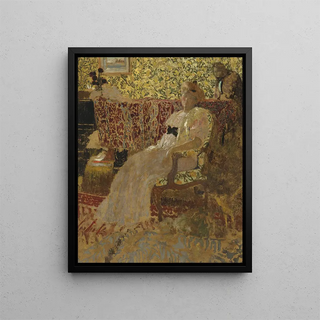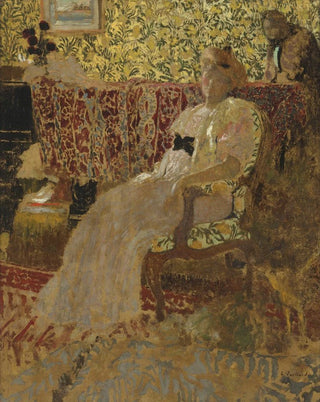Art print | La femme au fauteuil Misia et Thadée Natanson - Édouard Vuillard


View from behind

Frame (optional)
In the fascinating world of art, some works transcend the simple frame of painting to become witnesses of an era, reflections of social life and human emotions. "The woman in the Misia and Thadée Natanson armchair" by Édouard Vuillard perfectly fits into this category. This iconic piece, created at the turn of the 20th century, immerses us in the intimacy of a Parisian salon, where light, textures, and colors intertwine to create an atmosphere that is both warm and melancholic. The protagonist, Misia Natanson, the central figure of the scene, embodies the elegance and modernity of her time, while also reflecting the artistic aspirations of her husband, Thadée Natanson, an influential publisher and patron.
Style and uniqueness of the work
Vuillard's style is immediately recognizable, characterized by a palette of soft colors and delicate patterns. In this piece, the artist employs almost impressionist brushstrokes to capture the nuances of natural light flooding the room. The armchair in which Misia is seated, richly decorated with floral motifs, becomes a central element of the composition, symbolizing both comfort and the sophistication of bourgeois life. Vuillard skillfully plays with textures, making the fabric of the armchair and the softness of his model's skin almost palpable. The way he constructs space, by superimposing planes and playing with depth, gives an almost cinematic dimension to the scene, inviting the viewer to enter this fleeting moment of everyday life.
The artist and his influence
Édouard Vuillard, a member of the Nabis group, established himself as one of the major artists of his time. His work is characterized by a deep sensitivity towards interiors and scenes of daily life, revealing a rare intimacy. Influenced by Symbolist and Impressionist movements, he reinvents the representation of everyday life by infusing it with a poetic dimension. Vuillard also played a key role in redefining portraiture, moving away from academic conventions to prioritize

Matte finish

View from behind

Frame (optional)
In the fascinating world of art, some works transcend the simple frame of painting to become witnesses of an era, reflections of social life and human emotions. "The woman in the Misia and Thadée Natanson armchair" by Édouard Vuillard perfectly fits into this category. This iconic piece, created at the turn of the 20th century, immerses us in the intimacy of a Parisian salon, where light, textures, and colors intertwine to create an atmosphere that is both warm and melancholic. The protagonist, Misia Natanson, the central figure of the scene, embodies the elegance and modernity of her time, while also reflecting the artistic aspirations of her husband, Thadée Natanson, an influential publisher and patron.
Style and uniqueness of the work
Vuillard's style is immediately recognizable, characterized by a palette of soft colors and delicate patterns. In this piece, the artist employs almost impressionist brushstrokes to capture the nuances of natural light flooding the room. The armchair in which Misia is seated, richly decorated with floral motifs, becomes a central element of the composition, symbolizing both comfort and the sophistication of bourgeois life. Vuillard skillfully plays with textures, making the fabric of the armchair and the softness of his model's skin almost palpable. The way he constructs space, by superimposing planes and playing with depth, gives an almost cinematic dimension to the scene, inviting the viewer to enter this fleeting moment of everyday life.
The artist and his influence
Édouard Vuillard, a member of the Nabis group, established himself as one of the major artists of his time. His work is characterized by a deep sensitivity towards interiors and scenes of daily life, revealing a rare intimacy. Influenced by Symbolist and Impressionist movements, he reinvents the representation of everyday life by infusing it with a poetic dimension. Vuillard also played a key role in redefining portraiture, moving away from academic conventions to prioritize






